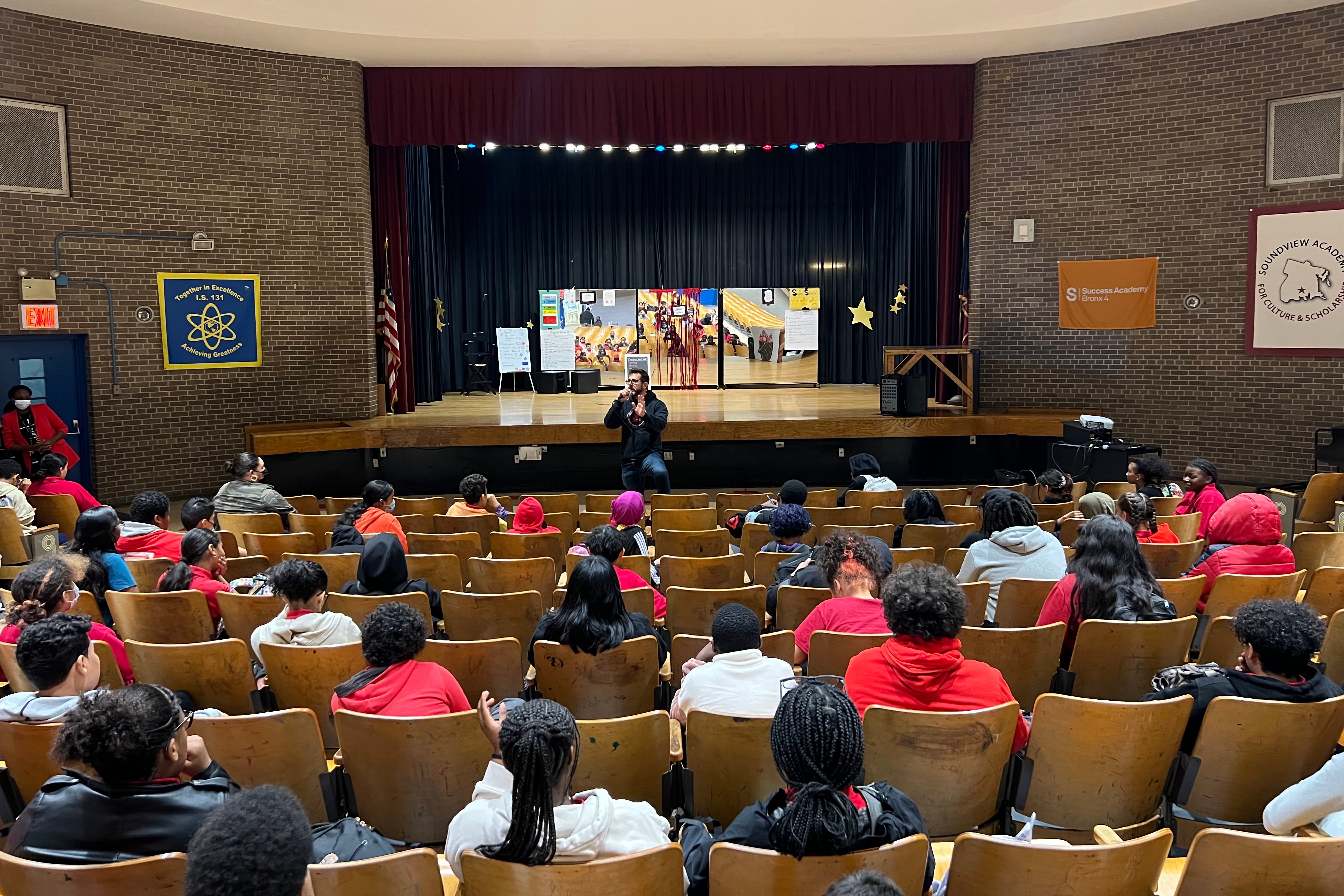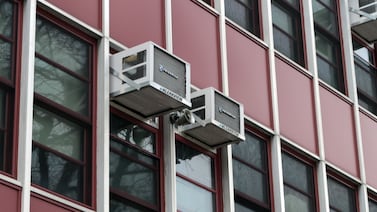Will Frackelton held a microphone in front of dozens of his seventh and eighth graders, wriggling in their seats in the auditorium that they share with two other Bronx schools.
Students and staff from Soundview Academy for Culture and Scholarship, where Frackelton is the principal, had gathered for a town hall last month that covered school safety, high school applications, and other topics. Before dismissing them, Frackelton made an unusual request: Would they help market the school over the next two weeks?
“I know you know kids that are in middle schools that are not happy, that don’t treat them like kids,” the middle school’s leader told the students. “I got 25 spots in the sixth grade, 25 spots in the seventh grade, 25 spots in the eighth grade, and if I don’t fill them with kids in 18 days, they’re gonna ask me this summer to let a bunch of teachers go.”
Frackelton’s request reflects a precarious budget situation facing many schools in a system where school funding is largely tied to enrollment, and enrollment has been plunging.
At the end of September, higher-ups at the education department informed Frackelton that they overestimated their enrollment projections used to calculate his school’s budget this year. With 75 fewer students than projected, his school owed the department about $750,000. If his roster didn’t grow by Oct. 31, he would either have to let go of several new teachers, or put the debt off until next year.
But Frackelton saw a third choice: Enroll 75 children before the deadline.
By the middle of the month, Frackelton had created a flier and a video to share on social media to entice families to enroll their children at Soundview, with the help of a former colleague who specializes in video production. Now, he was asking parents, staff and students, if they liked the school, to share the material everywhere.
Frackelton made this plea: “Find a kid, save a teacher.”
Enrollment declines put schools in tight spot
Many schools across New York City are facing enrollment declines. With 9.5% fewer students since the pandemic, most schools have seen budget cuts. As a result, many have larger class sizes and cuts to enrichment activities or extra programs for students.
During the pandemic, schools were held harmless for losing more students than projected. Now, schools are once again facing what is known as the “mid-year adjustment” — owing money if your roster is less than projected, or getting more if your numbers are higher. Department officials did not answer questions about how many schools fell below projections and owed money.
At the start of this school year, Soundview Academy enrolled just under 300 students, hitting a decade low. Though enrollment has dropped across the city since 2015, Soundview’s student body had been growing — until the pandemic.
Education department enrollment projections are rarely an exact science. Over the past decade, Soundview typically enrolled more students than projected. This year, they signed up 350 students by summertime. By September, staff were surprised that 75 of those children failed to show up. Frackelton assumed most had fled to charters, but found out only 11% of them did so. Nearly 60% left New York City. About 20% enrolled in other schools within Soundview’s district. The rest went to other district schools.
“In a post-pandemic New York public school reality, there’s just less kids, right, and there was no strategic plan,” for how schools like his should respond, Frackelton said. “So I decided, I’m just going to go for broke and see if we can come up with our own marketing strategy.”
Soundview Academy gets creative
By the day of the student town hall on Oct. 14, Frackelton’s school had enrolled roughly 10 more kids since he got the warning letter from the education department. That left 65 to go.
Kevin Lopez, a former staffer under Frackelton who is now an assistant principal at Manhattan’s High School of Art and Design, filmed footage for a 15-second promotional video at no cost to the school. It features Frackelton’s voice and clips of a couple of students talking about the school, as well as clips of students in classrooms.
It ends with an overhead shot of the school building and the school’s official seal, with the words, “WE CHOOSE YOU, ENROLL NOW!”
All fifth graders must apply to get into middle school in New York City. Like most city middle schools now, Soundview doesn’t screen elementary school students who want to enroll. It is also a community school this year, meaning that, because they serve a large share of high-needs students, the school partners with a nonprofit organization to provide wraparound support for children.
On the day before the student town hall, Frackelton’s team shared the promotional video on Instagram. During a parent association meeting that same evening, he pleaded with parents to spread the word on social media.
“I need you to come in tomorrow and grab some fliers, go to the buses, go to the trains, go down to that school, Bronx Charter [School] For The Arts, and get our kids back,” Frackelton told the group. (Bronx Charter School For the Arts did not immediately respond for comment.)
One of those new teachers is ErrDaisha Floyd, who teaches seventh grade social studies and is in her first year of teaching. Students are struggling more than she anticipated with reading difficult texts and staying focused. It’s been easier to help children one-on-one during periods when she has a special education teacher assist her class.
If there are big cuts to staff next year, it’s going to make school even harder, she believes.
“It’s just not fair for the students or the teachers because there will be a lot of students whose needs are not being met,” Floyd said.
Choosing to let go of teachers now would destroy the school’s programming, Frackelton said, right as staff is trying to help get students on grade level in reading and math, including through special periods dedicated to improving phonics and reading skills. Just under 6% of Soundview students passed state math tests last school year, compared with about 27% before the pandemic, but reading proficiency levels stayed about the same, with about 30% of students passing, according to data from the city and state. However, far fewer children took the tests last school year compared with 2019, making it difficult to make comparisons.
While Frackelton doesn’t believe the cuts would directly affect core instruction in reading and math, it’s likely that class sizes would grow. And funding cuts would mean paring back their dual language program — the only such middle school program in their district — far less arts and dance programming and courses in the school’s new technology lab that has 3D printers. Those are activities that the school pushes children to get involved in so that they can “find motivation” beyond academics, he said.
Cuts could also hamper the school’s efforts to pair students with teacher mentors. Those mentors currently have 10-15 students each and check in with them three times a day, but cuts to funding would mean cuts to staff, making it harder for teachers to build those connections. Many of the school’s children, 83% of whom are living in poverty and several of whom are transferring in from another school for safety reasons, benefit from having someone to talk to, Frackelton said.
Soundview’s focus on things beyond academics is what first attracted Farah Despeignes, the president of the parent association, to the school a few years ago. Her son didn’t want to attend their zoned school, so he applied to Soundview. He began pursuing dance, gymnastics, and cooking— activities he used to think of as reserved for girls — and began questioning traditional gender roles and stereotypes.
“It actually helped him to grow quite a bit,” Despeignes said of her son, now in high school.
He started at Townsend Harris High School in Queens this year, and her younger son is now an eighth grader at Soundview after they were both home-schooled last year.
Despeignes worried her children would get sick and that there were not enough social-emotional resources for students and staff — not just at Soundview, but citywide.
She sensed many families felt the same last school year and wondered if that’s why people left.
“We didn’t see that support network and those wraparound services,” Despeignes said. “For those reasons, I think that’s what created the situation we are seeing now.”
She also spread the word about the school, but she knew it would be hard to attract families who had already settled into their choices for the year. She’s hoping to share her view that things have been going well for her eighth grader.
“So far, so good,” she said.
Efforts fall short
By Oct. 25 — six days until the deadline — the school had enrolled about 15 new students.
But five had left.
Still the debt to the education department dropped significantly. The school now owes $490,000, Frackelton said.
His new goal is to get more students enrolled by next fall.
One day past the deadline, on Nov. 1, the school held its middle school fair. Frackelton said many people attended, and they handed out fliers left and right.
Reema Amin is a reporter covering New York City schools with a focus on state policy and English language learners. Contact Reema at ramin@chalkbeat.org.





